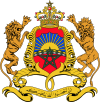Marinid dynasty | |||||||||
|---|---|---|---|---|---|---|---|---|---|
| 1244–1465 | |||||||||
![The Marinid sultanate circa 1360[1]](http://upload.wikimedia.org/wikipedia/commons/thumb/9/9c/Marinids_Zayyanids_and_Hafsids_c1360.png/250px-Marinids_Zayyanids_and_Hafsids_c1360.png) The Marinid sultanate circa 1360[1] | |||||||||
| Status | Ruling dynasty of Morocco | ||||||||
| Capital | Fez | ||||||||
| Official languages | Arabic[2] | ||||||||
| Common languages | Maghrebi Arabic, Berber languages | ||||||||
| Religion | Sunni Islam | ||||||||
| Sultan | |||||||||
• 1215–1217 (first) | Abd al-Haqq I | ||||||||
• 1420–1465 (last) | Abd al-Haqq II | ||||||||
| History | |||||||||
• Established | 1244 | ||||||||
• Disestablished | 1465 | ||||||||
| Currency | Dinar | ||||||||
| |||||||||
| History of Morocco |
|---|
 |
The Marinid dynasty (Arabic: المرينيون al-marīniyyūn) was a Berber Muslim dynasty that controlled present-day Morocco from the mid-13th to the 15th century and intermittently controlled other parts of North Africa (Algeria and Tunisia) and of the southern Iberian Peninsula (Spain) around Gibraltar.[3] It was named after the Banu Marin (Arabic: بنو مرين, Berber: Ayt Mrin[4]), a Zenata Berber tribe.[5][3] It ruled the Marinid sultanate, founded by Abd al-Haqq I.[5][6]
In 1244, after being at their service for several years, the Marinids overthrew the Almohads which had controlled Morocco.[7] At the height of their power in the mid-14th century, during the reigns of Abu al-Hasan and his son Abu Inan, the Marinid dynasty briefly held sway over most of the Maghreb including large parts of modern-day Algeria and Tunisia.[3] The Marinids supported the Emirate of Granada in al-Andalus in the 13th and 14th centuries and made an attempt to gain a direct foothold on the European side of the Strait of Gibraltar. They were however defeated at the Battle of Río Salado in 1340 and finished after the Castilians took Algeciras from the Marinids in 1344, definitively expelling them from the Iberian Peninsula.[8] Starting in the early 15th century the Wattasid dynasty, a related ruling house, competed with the Marinid dynasty for control of the state and became de facto rulers between 1420 and 1459 while officially acting as regents or viziers. In 1465 the last Marinid sultan, Abd al-Haqq II, was finally overthrown and killed by a revolt in Fez, which led to the establishment of direct Wattasid rule over most of Morocco.[3][9]
In contrast to their predecessors, the Marinids sponsored Maliki Sunnism as the official religion and made Fez their capital.[10][3] Under their rule, Fez enjoyed a relative golden age.[11] The Marinids also pioneered the construction of madrasas across the country which promoted the education of Maliki ulama, although Sufi sheikhs increasingly predominated in the countryside.[3] The influence of sharifian families and the popular veneration of sharifian figures such as the Idrisids also progressively grew in this period, preparing the way for later dynasties like the Saadians and Alaouites.[12]
- ^ Sluglett, Peter; Currie, Andrew (2014). Atlas of Islamic History. Routledge. p. 49. ISBN 9781317588979.
- ^ The Cambridge History of Africa: From c. 500 B.C. to A.D. 1050. Cambridge University Press. 1975. ISBN 9780521209816. Retrieved 28 July 2021.
- ^ a b c d e f Abun-Nasr, Jamil (1987). A history of the Maghrib in the Islamic period. Cambridge: Cambridge University Press. pp. 103–118. ISBN 0521337674.
- ^ Khaneboubi, A. (30 December 2010). "Mérinides (Berb. : Ayt Mrin)". Encyclopédie berbère (in French) (31): 4889–4895. doi:10.4000/encyclopedieberbere.568. ISSN 1015-7344.
- ^ a b "Marinid dynasty (Berber dynasty) - Encyclopædia Britannica". Encyclopædia Britannica. Retrieved 24 February 2014.
- ^ C.E. Bosworth, The New Islamic Dynasties, (Columbia University Press, 1996), 41-42.
- ^ Universalis, Encyclopædia. "MÉRINIDES LES". Encyclopædia Universalis.
- ^ Niane, D.T. (1981). General History of Africa. Vol. IV. UNESCO. p. 91. ISBN 9789231017100. Retrieved 24 February 2014.
- ^ Bosworth, Clifford Edmund (2004). "The Marīnids". The New Islamic Dynasties: A Chronological and Genealogical Manual. Edinburgh University Press. ISBN 9780748621378.
- ^ Ira M. Lapidus, Islamic Societies to the Nineteenth Century: A Global History, (Cambridge University Press, 2012), 414.
- ^ Le Tourneau, Roger (1949). Fès avant le protectorat: étude économique et sociale d'une ville de l'occident musulman. Casablanca: Société Marocaine de Librairie et d'Édition.
- ^ Lintz, Yannick; Déléry, Claire; Tuil Leonetti, Bulle (2014). Le Maroc médiéval: Un empire de l'Afrique à l'Espagne. Paris: Louvre éditions. pp. 432–435. ISBN 9782350314907.